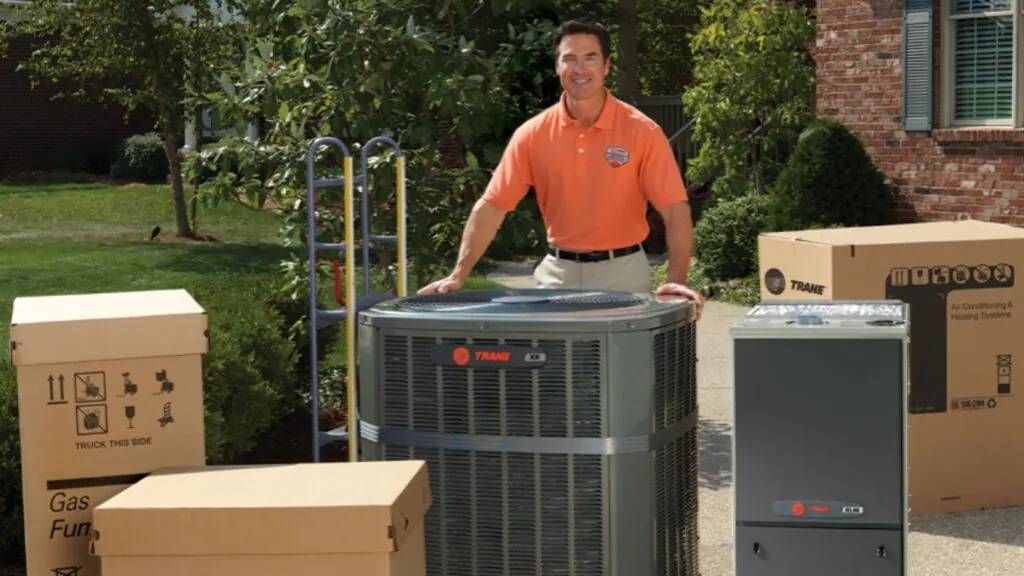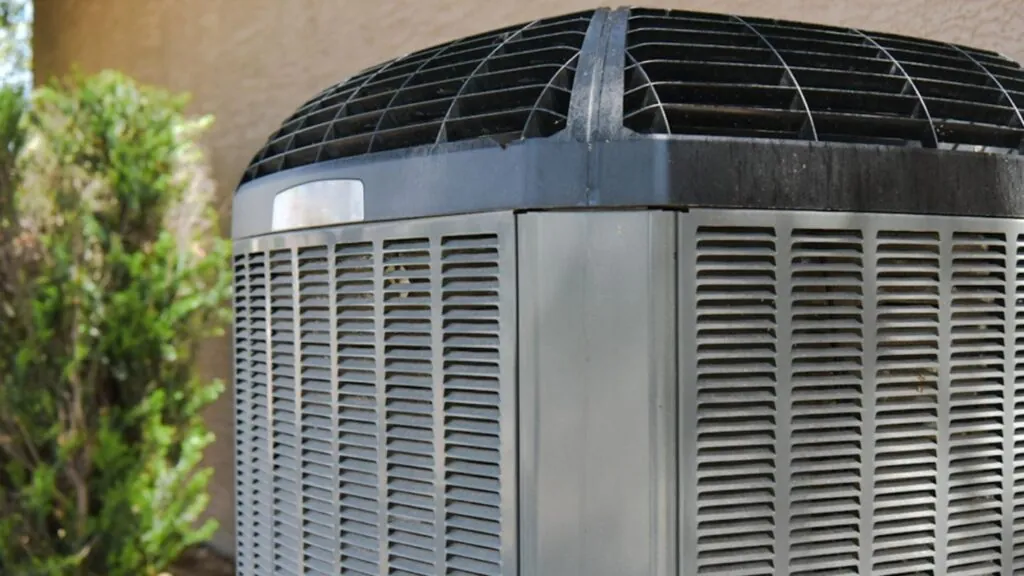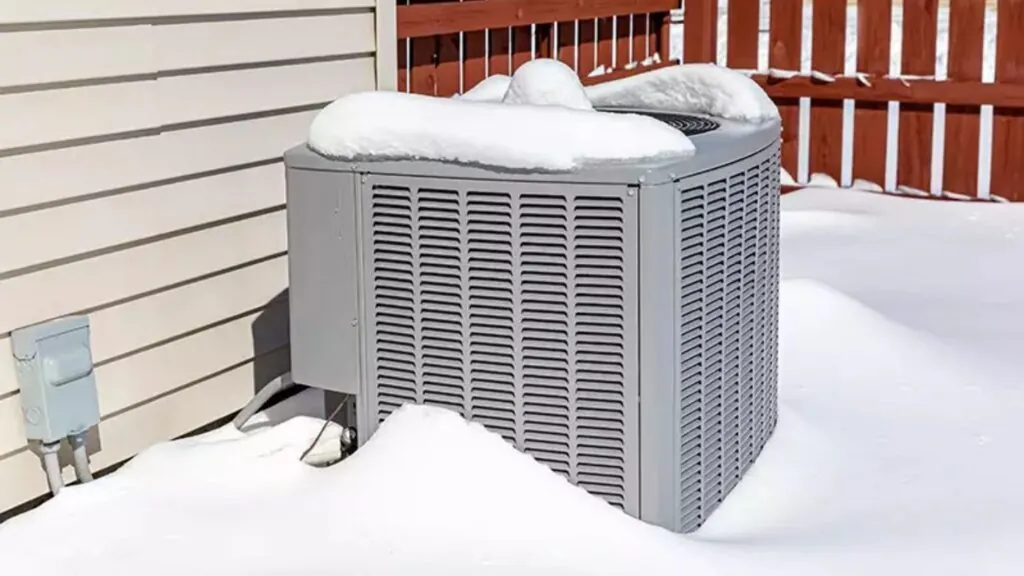How Does a Heat Pump Work in Winter? Explained for Cold Weather Efficiency
Wondering how does a heat pump work in winter? It’s quite ingenious. Despite cold outdoor temperatures, heat pumps can extract available heat from the air and transfer it inside to warm your home. In this article, we’ll break down the technology that makes this possible, explore the different types of heat pumps, and discuss how they maintain efficiency even in freezing conditions.
Key Takeaways
- Heat pumps work by transferring heat from outside to inside, providing efficient heating even in cold weather.
- Modern heat pumps are equipped with technologies like variable-speed compressors and cold-weather refrigerants that enhance their performance in freezing temperatures.
- Switching to heat pumps can significantly lower energy bills, reduce carbon emissions, and improve indoor air quality compared to traditional heating systems.
Understanding Heat Pumps

Heat pumps stand as technological wonders within the realm of HVAC, offering a dual-function system capable of both heating and cooling. These systems differ significantly from traditional heating setups by moving heat between areas rather than producing it, which allows for exceptional efficiency and adaptability in climate control tasks — ensuring your home stays cool during hot months and warm when winter strikes.
The efficiency with which heat pumps operate across different climates stems from their core mechanism: the transfer of thermal energy instead of its direct creation. This trait renders them an ideal solution for environments that range from mild to harshly extreme.
To gain better insight into why heat pumps are so effective, we’ll delve into examining various types available and dissect how they work.
What is a Heat Pump?
Heat pump technology employs a method of transferring heat from an external source to the interior of a building, as opposed to directly generating warmth. Even when it’s cold outside, these systems have the capability to harness thermal energy from the outdoor air and funnel it indoors for comfort regulation. Despite seeming somewhat illogical, advanced technologies enable heat pumps to move warmth into a space that is already warmer than the cold exterior environment.
The functionality of heat pumps involves moving refrigerant in a looped process involving both evaporation and condensation phases. This cycle enables them to absorb and emit thermal energy accordingly. Within your home, this captured heat is dispersed through either ductwork or directly by an indoor unit if part of a ductless system—thereby ensuring even heating distribution throughout your living area for sustained temperature control.
Recent advancements in how these devices operate include improvements like heightened compressor capacities and more effective airflow rates, which render contemporary models notably efficient compared with their predecessors. For properties lacking traditional HVAC infrastructure such as ducts, there are specialized options available: Ductless heat pumps can provide non-stop circulating warm air that significantly boosts climate management inside one’s abode without compromising on coziness or efficiency.
Types of Heat Pumps
Numerous heat pump variants exist, each tailored for specific heating and cooling requirements. Air-source heat pumps and ground-source (or geothermal) heat pumps are among the most prevalent types. By drawing from the outside air to either extract warmth during colder months or dispense it in warmer seasons, air source heat pumps offer a flexible solution that’s popular across diverse applications. Blocpower’s newer versions of these devices enhance their efficiency and adaptability, especially in areas with fluctuating temperatures.
Alternatively, ground source (geothermal) heat pumps exploit the earth’s constant subterranean temperature for their climate control processes. While offering significant energy efficiency gains, they typically necessitate more complex installation procedures than air-source varieties.
Both kinds serve as integral components within contemporary heating and cooling systems by providing a highly efficient alternative to conventional heating approaches such as those utilized by traditional methods like fossil fuel-based systems.
How Heat Pumps Operate in Winter

Even during the colder months, heat pumps are engineered to function efficiently by drawing warmth from outdoor air and channeling it inside. While this may seem unlikely in particularly cold climates, these systems can indeed pull heat from sub-zero ambient air. Their successful performance in places with severe winter seasons, like Scandinavia, attests to their ability to provide indoor heating under tough conditions.
To maintain the peak efficiency of heat pumps throughout the winter season, it’s essential to keep them clear of any obstructions, such as leaves or debris, that could impede airflow. We will explore how heat pumps maintain efficient operations in chilly weather by discussing aspects such as the refrigeration cycle, the importance of specialized refrigerants for low temperatures, and improvements made within compressor technologies.
Refrigeration Cycle in Winter
At the core of a heat pump’s functionality is the refrigeration cycle, which relies on essential components like the compressor, condenser, expansion valve, and evaporator. In chilly conditions during winter months, this system cycles refrigerant between gas and liquid states to adjust its temperature so that it can harvest warmth from cold outside air. This enables the heat pump to convey thermal energy into space even when faced with extremely low temperatures.
When set to heating mode:
- The outdoor air’s thermal energy is absorbed by the refrigerant in the exterior coils as it turns into a low-pressure vapor.
- Following absorption, this vapor gets compressed and heats up significantly.
- Subsequently transported inside through an exchanger located within an indoor unit. Here lies where heated gas discharges its warmth.
- As it relinquishes its collected heat energy indoors —the interior atmosphere becomes warmer— preparing for another iteration of cycling.
Despite operating in the cold temperatures that challenge traditional heaters, heat pumps achieve efficiency rates three times higher than conventional systems. This is because they excel at transferring ambient warmth efficiently, as demonstrated by their SCOP across varying seasons. They can potentially cut energy usage in half compared to traditional heating methods, providing cost-effective and sustainable heating solutions. This advanced technology ensures cozy homes without compromising utility resources, reflecting a significant leap in climate control capabilities. Their widespread adoption and consumer acclaim highlight their superior performance and fiscal benefits, making them a smart investment for modern households.
Cold-Weather Refrigerants
Heat pumps designed for cold climates feature refrigerants that boil at lower temperatures compared to those in standard heat pump systems. This attribute ensures they remain effective and efficient even when the mercury dips substantially, making them well-suited for operation in areas known for extremely cold weather. Certain models of these cold climate heat pumps are engineered to perform reliably in conditions where the temperature falls to -20°F, demonstrating their robustness and suitability for challenging winter environments.
The incorporation of such specialized refrigerants enables these heating systems to draw warmth from the outdoor air effectively under low-temperature scenarios, delivering consistent interior comfort levels. As a viable heating solution in locales frequently subjected to heat.
Enhanced Compressor Technology
Enhanced compressor technology has notably increased the performance of heat pumps under cold conditions. While conventional heat pumps often had difficulties functioning efficiently at temperatures around -13°F, updated versions equipped with advanced compressors have been designed to work proficiently even when the mercury dips as low as -22°F.
This progression confirms that in even the most frigid environments, heat pumps stand as a dependable and energy-efficient option for heating, consistently offering coziness and warmth.
Special Features for Cold Weather Performance

Heat pumps nowadays are outfitted with advanced functionalities tailored to bolster their effectiveness in cold-weather environments. These enhancements include reduced rates of ambient airflow and a boost in compressor capacity, along with modifications to the compression cycle setup. Such improvements enable heat pumps to maintain efficient operation even when temperatures plunge below -20°F, ensuring they meet heating requirements reliably even in extremely cold climates.
Contrary to the widespread belief that heat pumps falter under frigid climate conditions, technological advancements have paved the way for their steady performance during freezing temperatures. Models such as the Multi++. Ultra is specially engineered to operate proficiently amidst severely cold weather, demonstrating that heat pumps can indeed serve as a viable and strong heating solution throughout winter months.
Variable-Speed Compressors
Variable-speed compressors stand as a crucial component within cold climate heat pumps, granting these units the ability to modify their functioning speed instantaneously in accordance with the required temperature levels. This flexibility ensures that the heat pump functions proficiently, supplying steady warmth while avoiding unnecessary energy usage. By altering their velocity, variable-speed compressors are instrumental in preserving a consistently comfortable indoor atmosphere despite variations in external temperatures.
In regions characterized by cold climates where substantial shifts in temperature frequently occur, this technology proves especially beneficial. As they perpetually adapt to the precise heating needs at any given time, variable-speed compressors significantly boost both the efficacy and operational capability of the heat pump. These features render them indispensable for reliable heating during winter months.
Defrosting Mechanisms
In the cold winter months, it’s not uncommon for ice to build upon the exterior parts of heat pumps, potentially impairing their functionality. To address this issue, contemporary heat pumps incorporate defrosting systems designed to kick in and stop ice from developing. These self-regulating defrost cycles span between 10 and 15 minutes, which is critical in making sure that the performance of the heat pump remains uninterrupted and efficient.
To maintain peak operational capacity by keeping airflow unobstructed during such icy conditions, these units initiate a defrost mode where they warm up their external coils to dissolve any accumulated ice. This capability plays a vital role in preventing harm to the system while assuring continuous delivery of warmth through heat pumps even amidst freezing temperatures.
Improved Airflow Systems
Modern heat pumps are equipped with upgraded airflow systems that facilitate better distribution of warmth, thus enhancing their efficiency in cooler environments. The presence of a larger area for heat exchange, the incorporation of grooved copper tubes, and coil coatings resistant to corrosion crafted from acrylic resin all play a role in elevating performance levels. These advancements aid in ensuring optimal transfer and dissemination of heat, which boosts the overall efficacy of the pump.
These sophisticated airflow mechanisms contribute significantly to optimizing the process by which these pumps exchange heat. Consequently, they enable heat pumps to operate effectively even when faced with low ambient temperatures. Such improvements provide steady indoor heating comfort and elevate general functionality during colder months—positioning modern-day heat pumps as dependable options for maintaining warmth through winter seasons.
Comparing Heat Pumps to Traditional Heating Systems

Heat pumps have numerous advantages when compared to conventional heating systems such as gas furnaces. Their efficiency is notably higher, attaining a heating output that can exceed the electrical input by over threefold. This high level of energy efficiency leads to decreased energy usage and, subsequently, lower utility expenses for those who install them in their homes.
Heat pumps are more environmentally friendly than traditional methods of heating because they harness ambient heat rather than relying on the combustion of fossil fuels. As a result, they emit fewer greenhouse gases, making them an integral component for achieving greener and more sustainable home heating options.
Throughout this discussion, we will delve deeper into these various benefits — examining aspects such as increased energy efficiency, cost-effectiveness relative to savings on utilities and lessening environmental impacts associated with traditional means of producing warmth at home.
Energy Efficiency
Heat pumps have gained recognition for their remarkable energy efficiency, utilizing far less energy compared to conventional heating systems. Air source heat pumps are especially capable of cutting down on electricity usage by up to 50% when pitted against electric furnaces for heating purposes. The Heating Seasonal Performance Factor (HSPF) is a metric that gauges the proficiency with which these systems can consistently provide warmth efficiently over the course of a season.
In more temperate conditions, cold climate heat pumps exhibit outstanding efficacy rates reaching as high as 400%, positioning them among the top-tier options in terms of energy-efficient heating. Rather than producing heat directly, these types of systems work by shifting existing thermal energy from one place to another. This process substantially diminishes overall energy use and contributes to reduced heating bill expenses while simultaneously minimizing environmental impact through lower carbon emissions associated with traditional heating mechanisms.
Cost Savings
Transitioning from traditional heating systems like gas furnaces to heat pumps can significantly reduce utility expenses, as homeowners might see an annual reduction of around $459 on energy bills when moving away from electric furnaces. The upfront cost associated with installing a heat pump is usually offset by the long-term decrease in energy costs, rendering heat pumps economically beneficial for numerous families over time.
Yet, during episodes of extreme cold where the capacity of heat pumps may be insufficient for meeting household warmth requirements, supplementary emergency heating methods could necessitate additional expenditures. It’s essential to incorporate these potential increases in energy bills into comprehensive financial evaluations.
Despite these considerations, customers who upgrade to high-HSPF (Heating Season Performance Factor) rated heat pumps frequently benefit from considerable savings on their yearly expenses associated with both heating and cooling needs.
Environmental Impact
Utilizing ambient heat instead of burning fossil fuels, heat pumps present considerable environmental advantages over traditional heating systems. They stand out by diminishing greenhouse gas emissions, which in turn contributes to a smaller carbon footprint and aids in the reduction of total carbon emissions.
As an eco-friendly option for individuals aiming to lessen their ecological impact while keeping their living spaces cozy, heat pumps serve as a sustainable substitute that supports comfort without compromising environmental integrity.
Practical Considerations for Using Heat Pumps in Winter
To guarantee that heat pumps function effectively during the winter, certain practical measures must be taken. Ensuring your home is well-insulated and airtight is critical for maintaining peak efficiency of heat pumps when temperatures drop. It’s equally important to keep the unit clear of obstructions and to maintain proper airflow around it for optimal operation.
Upholding routine upkeep is vital in sustaining efficient performance from heat pumps all year round, with particular attention needed in the colder season. Professional servicing can preemptively address any problems, which helps preserve your heat pump’s effectiveness over time.
In our discussion, we’ll delve into strategies like consistent maintenance checks, additional heating solutions if necessary, and advice on installing your system correctly – all designed to bolster your heat pump’s proficiency amidst winter conditions.
Regular Maintenance
Ensuring that your heat pump continues to function effectively during the winter months requires consistent maintenance. Homeowners are advised to undertake necessary, albeit minor, routine check-ups for the smooth operation of their system. It’s equally critical to clean air filters regularly in order to sustain ideal airflow and performance levels. Such straightforward care routines can avert typical issues while increasing the durability of the heat pump.
For elementary upkeep tasks, enlisting professional maintenance services is key for comprehensive examinations and adjustments of your unit. These professionals are equipped to detect and rectify incipient problems promptly, which facilitates dependable and efficient heating throughout the cooler season.
Engaging in frequent maintenance not only boosts the efficiency but also prolongs the service life of your heat pump—a valuable long-term investment for homeowners.
Supplemental Heating Options
In regions where the temperature drops drastically, heat pumps might not always be able to keep up with maintaining comfortable indoor temperatures. This often compels homeowners to seek out emergency heating solutions such as electric baseboard heaters or gas furnaces when faced with extreme cold periods. While these alternatives provide the necessary warmth, they have a tendency to elevate energy expenses and impact household heating budgets.
For those who depend on heat pumps during colder seasons, it’s essential to comprehend how additional supplemental heating will interact. Homeowners can prepare for these extra requirements by integrating energy-efficient supplemental heating methods that ensure their residence stays cozy without racking up high costs.
Adopting a strategy that mixes heat pumps with supplementary heating techniques offers a harmonized solution for managing residential warmth throughout winter months in cold climates.
Installation Tips
It is critical for the peak functioning of heat pumps, especially during the cold months, to install them correctly. It’s important that they are situated where there is sufficient airflow and shielded from harsh weather elements. Insulation of any exposed pipes and lines also helps avert freezing issues and maintains steady heating.
Adhering to these guidelines when setting up your heat pump system can enhance both its efficacy and durability.
Benefits of Heat Pumps in Cold Climates

Homeowners residing in colder regions can reap substantial advantages from heat pumps. They serve as an energy-efficient source of warmth, potentially cutting the demand for heating energy by 35% to 50%. The latest advancements in heat pump technology, including ductless systems, have been calibrated to deliver unwavering warmth even when faced with frigid conditions, establishing them as reliable options for cold-weather comfort.
Opting for a heat pump is not only efficient but also economically favorable. Homeowners could observe significant financial savings—possibly amounting to thousands each year on their heating expenditures. Compared to conventional heating methods, these units emit lower levels of carbon dioxide, which bolsters both environmental health and the quality of air within homes.
We will delve into these points more deeply in subsequent sections below.
Year-Round Comfort
Contemporary heat pumps tailored for cold climates deliver reliable year-round temperature regulation, offering both heating in the winter and cooling in the summer to maintain a comfortable home environment irrespective of seasonal changes. Employing these heat pumps throughout all seasons can heighten comfort indoors and boost energy efficiency, positioning them as an adaptable option for residential use.
By using cold climate heat pumps that cater to annual climatic demands, homeowners no longer require distinct systems for heating and cooling. This integration streamlines managing domestic climate conditions while significantly improving energy efficiency, consequently, diminishing expenses related to both heating and cooling your home.
Lower Utility Bills
Utilizing heat pumps can result in considerable reductions in monthly utility expenses because of their superior efficiency. Cold climate heat pumps are capable of achieving efficiencies as high as 400%, which can drastically decrease the energy bills for homeowners.
These cold climate heat devices provide a financially viable option to keep homes comfortable year-round by cutting down on energy consumption.
Improved Indoor Air Quality
By filtering and circulating air, heat pumps improve the quality of indoor air, reducing pollutants and fostering a more salubrious living space. In contrast to conventional heating systems, they produce lower amounts of carbon dioxide, thus promoting a cleaner and greener environment.
The combination of effective heating capabilities and betterment in air quality positions heat pumps as an ideal option for contemporary residential settings.
Total Comfort Cooling Services
Total Comfort Cooling & Heating, Inc. specializes in a wide array of HVAC services to maintain optimal comfort in your home throughout the year. We are committed to delivering customized support that encompasses installation, routine maintenance, and repair work for peak performance and dependability of your HVAC equipment. Whether you’re in need of an entirely new heat pump, air conditioner, or a comprehensive heating system overhaul, our proficient team stands ready to assist.
To installations, we offer extensive HVAC solutions across Venice, such as AC repairs and installations, along with heating services, including upkeep programs designed specifically for uninterrupted operational excellence of your system. Leveraging our proficiency in this field ensures that, irrespective of weather changes. You can count on us to keep your living space cozy at all times.
Professional Installations
Our expert installation offerings are tailored to cater to your unique requirements, guaranteeing maximum efficiency and optimal functioning. We are proficient in setting up AC units, heat pumps, furnaces, and ductless systems, delivering customized solutions that align perfectly with the needs of your residence.
We commit ourselves to a methodology that ascertains proper setup and peak operational performance of your HVAC system.
Comprehensive Maintenance Plans
Total Comfort Cooling provides extensive maintenance programs that aim to extend the lifespan and improve the functionality of your HVAC system. These packages encompass immediate service on the same day, pre-arranged upkeep appointments, and strategies for lengthening your system’s operational life, ensuring it operates effectively.
The purpose of these plans is to safeguard your investment in HVAC equipment and guarantee its dependable functioning throughout all seasons.
Emergency Services
Total Comfort Cooling is committed to delivering prompt and efficient solutions for urgent HVAC issues with our 24-hour emergency service. You can rely on us to provide immediate assistance at any time, maintaining the comfort and safety of your home.
Our dependable support is available around the clock because we know that HVAC problems can occur without warning. Whenever you’re in need, trust that Total Comfort Cooling will be there quickly to resolve any unexpected HVAC concerns.
Summary
In summary, heat pumps offer a highly efficient and cost-effective solution for winter heating, even in the coldest climates. By transferring heat rather than generating it, heat pumps provide reliable warmth while reducing energy consumption and environmental impact. Understanding how heat pumps operate, maintaining them properly, and integrating supplemental heating options can help you make the most of this advanced technology.
Choosing a heat pump for your home not only ensures year-round comfort but also leads to significant savings on utility bills and improved indoor air quality. With HVAC in Venice by Total Comfort Cooling & Heating, Inc., you can trust that your heat pump system will be installed and maintained to the highest standards, providing you with peace of mind and a comfortable home environment.
Frequently Asked Questions
How often should HVAC maintenance be scheduled?
Scheduling HVAC maintenance twice a year, once in spring and once in fall, is ideal to keep your system running efficiently. This routine care can prevent larger issues down the line.
What factors are considered when determining the right size HVAC unit?
When figuring out the right size HVAC unit, you’ll want to consider your home’s age, the number of windows, room sizes, average climate, and insulation quality.
These factors all play a crucial role in ensuring your system is efficient and effective.
Why are heat pumps considered efficient in Port Charlotte’s climate?
Heat pumps are efficient in Port Charlotte’s climate because they transfer heat instead of generating it, making them perfect for the area’s moderate temperatures.
This means you can enjoy comfortable indoor spaces without high energy bills!
What services does Total Comfort Cooling & Heating, Inc. provide in Venice, FL?
Total Comfort Cooling & Heating, Inc. offers HVAC services like AC repair, installation, heating solutions, and maintenance in Venice, FL.
They’ve got you covered for all your comfort needs!
What benefits are included in the Total Comfort Cooling & Heating Service Plan?
The Total Comfort Cooling & Heating Service Plan offers same-day service, scheduled maintenance visits, and $50 savings, all aimed at maximizing system lifespan and efficiency.
It’s a great way to keep your HVAC running smoothly!
READY FOR YOUR NEXT HEATING OR COOLING PROJECT?
Contact us to get a quote and see why our customer service is recognized as the best in the industry.







 Special Offer: 12 Months - No Interest, No Payments!
Special Offer: 12 Months - No Interest, No Payments!